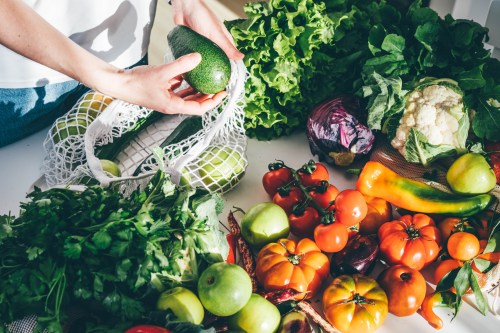Your guide to buying and drinking truly sustainable wine
What is sustainable wine and how can you easily find it? Consider this your easy guide to the world of organic, biodynamic, natural wines and more.

Thanks to climate change, people are more willing than ever to go “green” with their eating habits, from going plant-based (at least some of the time) to cutting back on their food waste. So it should be no surprise that many people are interested in making their beverages more eco-friendly, too—right down to buying and drinking sustainable wine.
However, when it comes to choosing eco-conscious vino, things can get a little murky. There are a variety of sustainable certifications for wine, says Diego Meraviglia, president and director of education at the North American Sommelier Association.
“There’s a lot of confusion about what sustainable, organic, and biodynamic wines mean,” says Meraviglia. “They often get mixed up and are used interchangeably, but they actually mean very different things.”
Much like the way supplements aren’t regulated by the FDA, there isn’t a body of government that oversees sustainable practices in winemaking. Not to mention, there are many labels on wine that sound eco-friendly but don’t necessarily mean green. So how do you make sure that your reds and rosés are sustainable, too? Here’s what to know.
So what is sustainable wine, exactly?
Sustainable wine refers to the farming and winemaking practices that winegrowers follow, Meraviglia says. To be certified sustainable, wineries and vineyards must have an independent third party evaluate their farming practices and see if they meet certain eco-friendly standards. These standards run the gamut of composting waste to make fertilizer, conserving water, and reducing energy consumption and pesticide use. LIVE, for example, is a nonprofit organization that certifies sustainable practices of winegrowers in the Pacific Northwest. For vineyards (aka land where the grapes are grown), they require all LIVE members to report their farming records for biodiversity, irrigation and fertilizer use, among other things. For wineries (aka where wine is actually made), they ask for records of energy use and greenhouse gas emissions, as well as water management and employee health and safety.
The California Sustainable Winegrowing Alliance, LODI Rules, and SIP are other well-known non-profit organizations that promote and certify sustainable wines. You might also see the Environmental Management Systems (EMS) under ISO 14001 on wine labels from other wine-making countries like Chile and Australia. EMS is an independent international organization that equips companies with tools and information to reduce waste and practice environmental responsibility.
What does sustainability at vineyards look like IRL?
Benziger Family Winery in Sonoma, California is one of the most well-known sustainable vineyards in the U.S. and is certified through Stellar Certification Services, a third-party organization that recently partnered with California Certified Organic Farmers (CCOF) to promote and issue organic certification. Chris Benziger, vice president of trade relations at Benziger Family Winery, oversees many of the farm-related duties at the vineyard.
“We practice sustainability by promoting more biodiversity in our vineyards,” Benziger says. (Biodiversity = the variety of life in a particular habitat or ecosystem.) “Instead of spraying Roundup, for example, to kill leafhoppers, we created these insectaries [plants that attract pests to keep them off crops] and have birds to keep pests down,” he explains.
Benziger says they also use a water-saving system that allows water to naturally purify itself. “We filter our waste water through constructed wetlands filled with diverse plants that scrub the water within the roots of the plants, purifying it. The water then collects in a second pond, where it is distributed throughout the property. We have recycled millions of gallons of water in this way,” he says. They also use solar panels and energy-efficient equipment in their wineries.
Sustainability has always been important to Benziger, but that’s become even more crucial given how the California wine business has suffered in recent years from the climate crisis. Last October, the raging Kincade fires devastated nearly 16,000 acres of land, including Sonoma wine country. “The fires have been the most dramatic effect of climate change. We have experienced two major fire events in the last three years. That is unprecedented. The 2017 fire burned through one of our wineries,” Benziger says.
This has changed how some winemakers and farmers work. “In warmer climates, farmers need to harvest earlier to prevent over-ripening grapes, which make the wine very sweet and raises the ABV,” Meraviglia says. “As a result of climate change, we use more shade cloth now to help protect the fruit from sunburn,” Benziger adds.
But in some cases, climate change has been a positive thing for winegrowers. “In certain regions where it used to be too cold to make wine, climate change has given them the opportunity to make wine,” Meraviglia says. Examples include England, Belgium, and even Denmark—never places historically known for winemaking.
How is this different from organic and biodynamic wine?
Here’s the sometimes-confusing part: Many sustainable wineries also follow organic and biodynamic farming practices. Benziger Family Winery, for example, has four estate Biodynamic-certified vineyards. But not all organic or biodynamic wines are automatically sustainable.
The United States Department of Agriculture (USDA) is the only body that can issue certified organic labeling on wine bottles. In order for a wine to be certified USDA organic, the grapes used in the wine must be organic and the wine-making process should also be organic. This means that not only are the grapes to be grown without the use of pesticides or GMOs, but everything that goes into the wine (such as the yeast used for fermenting) must be organic, too.
While organic sounds good in practice, the quality of the wine often suffers, Meraviglia says. “It’s very rare and difficult to make good wine organic. To make wine, you have to do a lot of man-made things. There are a lot of organisms, bacteria and yeasts out there that can spoil wine, so you need to add things to it that aren’t organic to prevent this from happening,” Meraviglia says.
Meanwhile, biodynamics is a holistic farming practice that originated from Austrian philosopher Rudolf Steiner in the 1920s. Biodynamics takes organic farming to a spiritual level by taking into account the different phases of the moon, Meraviglia says. (Yes, you read that right.) “You harvest grapes when the moon is in a certain position, and it [is believed to have] a direct effect on the wine’s character and behavior. But organic stops at the farming level,” Meraviglia says.
In order for vineyards and wineries to be certified biodynamic, they must meet the strict standards set by the Demeter Association, Inc., a nonprofit organization that certifies biodynamic practices. Wines that carry the Demeter certification (and thus are marked “Biodynamic,” “Demeter,” or “Demeter Certified Biodynamic”) meet the minimum requirements for biodynamic farming, such as setting aside 10 percent of acreage for a “biodiversity preserve,” and shunning synthetic pesticides and herbicides.
But what about the health benefits of wine itself? Here’s the lowdown from a top dietitian:
Biodynamic farmers believe that their processes are deeply beneficial for the environment. For example, biodynamic vineyards typically have animals, like goats, chickens and sheep, to eat the wheat and weeds around the grape vines, Meraviglia says, which allows the grape vines to reap all the nutrients from the soil. Animals also eliminate the need to use herbicides, and their waste fertilizes the soil. “The base of [biodynamic farming] is the idea of being connected to the land. A good farmer leaves his footprints in the vineyard,” Benziger says.
The downside, Meraviglia says, is that there is often inconsistency and unpredictability in the quality of biodynamic wine. “One vintage might taste great but another vintage of the same batch might not,” he says. He also says there isn’t a ton of science to substantiate certain aspects of biodynamic farming.
However, Benziger contends that biodynamic wines have the most authentic flavors. “Biodynamic wines aren’t necessarily the best because ‘best’ has a bias, but everyone can agree that biodynamic wines are truly original. They aren’t cookie cutter wines,” he says. “I like to look at biodynamic wines as time capsules. Maybe 2011 was a much cooler year, so this vintage has a bit more acid in it. The vintage variation is what makes the wine interesting.”
How can I easily buy sustainable wine?
So what does this all mean for your next happy hour? If you want to choose good-quality wine that’s also sustainable, take time to learn more about where the wine came from and how the grapes are produced. “Knowing what wine is and how it’s made is at the core of making the right choice and choosing something that’s quality oriented,” Meraviglia says. The easiest way to do so is to look for some of the above-mentioned third-party labels—such as EMS or LIVE—on bottles of wine when you shop.
Most importantly: “Stay away from wines less than $10,” says Meraviglia. “These are wines that are often completely industrial and mass-produced,” aka not very likely sustainable. Otherwise, he says there aren’t any other labels you should be too concerned with. “At the end of the day, if you like it, you like it.” Cheers to that!
Because spring is coming…here are some of the best canned wines to sip on. And WTF is up with that one friend who never gets hangovers?
Sign Up for Our Daily Newsletter
Get all the latest in wellness, trends, food, fitness, beauty, and more delivered right to your inbox.
Got it, you've been added to our email list.










